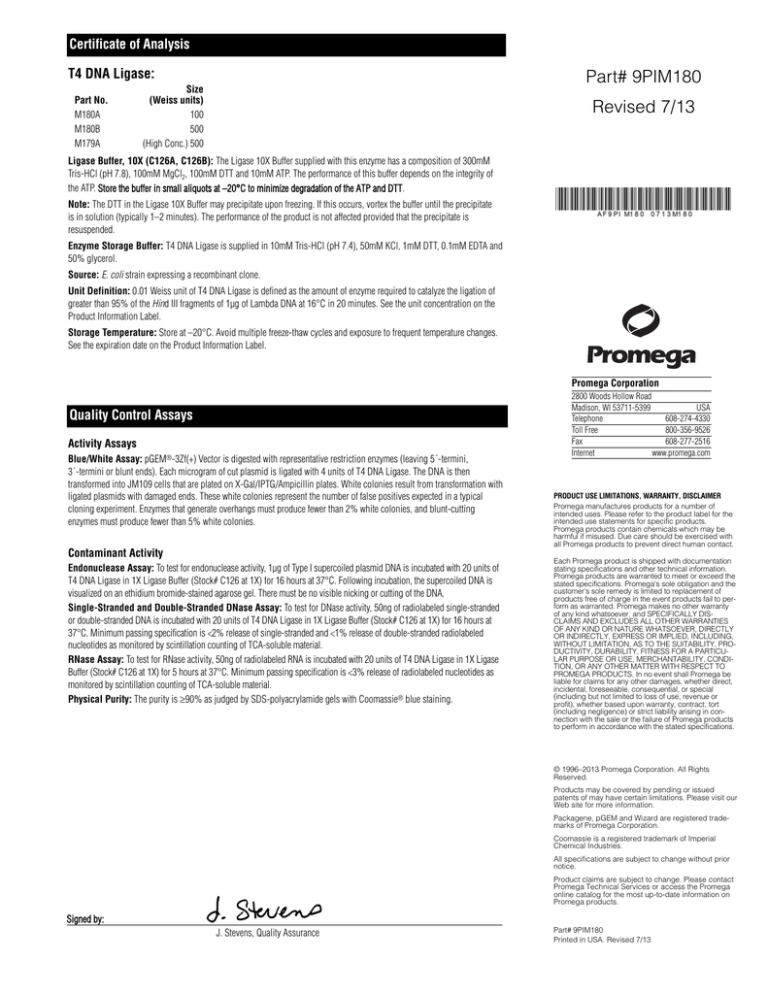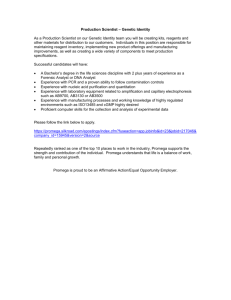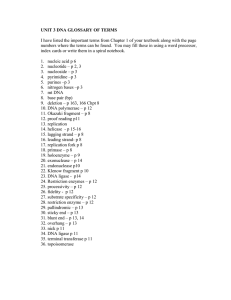
Certificate of Analysis
T4 DNA Ligase:
Part No.
M180A
M180B
M179A
Part# 9PIM180
Size
(Weiss units)
100
500
(High Conc.) 500
Revised 7/13
Ligase Buffer, 10X (C126A, C126B): The Ligase 10X Buffer supplied with this enzyme has a composition of 300mM
Tris-HCl (pH 7.8), 100mM MgCl2, 100mM DTT and 10mM ATP. The performance of this buffer depends on the integrity of
the ATP. Store the buffer in small aliquots at –20°C to minimize degradation of the ATP and DTT.
Note: The DTT in the Ligase 10X Buffer may precipitate upon freezing. If this occurs, vortex the buffer until the precipitate
is in solution (typically 1–2 minutes). The performance of the product is not affected provided that the precipitate is
resuspended.
Enzyme Storage Buffer: T4 DNA Ligase is supplied in 10mM Tris-HCl (pH 7.4), 50mM KCl, 1mM DTT, 0.1mM EDTA and
50% glycerol.
Source: E. coli strain expressing a recombinant clone.
Unit Definition: 0.01 Weiss unit of T4 DNA Ligase is defined as the amount of enzyme required to catalyze the ligation of
greater than 95% of the Hind III fragments of 1µg of Lambda DNA at 16°C in 20 minutes. See the unit concentration on the
Product Information Label.
Storage Temperature: Store at –20°C. Avoid multiple freeze-thaw cycles and exposure to frequent temperature changes.
See the expiration date on the Product Information Label.
Promega Corporation
Quality Control Assays
Activity Assays
Blue/White Assay: pGEM®-3Zf(+) Vector is digested with representative restriction enzymes (leaving 5´-termini,
3´-termini or blunt ends). Each microgram of cut plasmid is ligated with 4 units of T4 DNA Ligase. The DNA is then
transformed into JM109 cells that are plated on X-Gal/IPTG/Ampicillin plates. White colonies result from transformation with
ligated plasmids with damaged ends. These white colonies represent the number of false positives expected in a typical
cloning experiment. Enzymes that generate overhangs must produce fewer than 2% white colonies, and blunt-cutting
enzymes must produce fewer than 5% white colonies.
Contaminant Activity
Endonuclease Assay: To test for endonuclease activity, 1µg of Type I supercoiled plasmid DNA is incubated with 20 units of
T4 DNA Ligase in 1X Ligase Buffer (Stock# C126 at 1X) for 16 hours at 37°C. Following incubation, the supercoiled DNA is
visualized on an ethidium bromide-stained agarose gel. There must be no visible nicking or cutting of the DNA.
Single-Stranded and Double-Stranded DNase Assay: To test for DNase activity, 50ng of radiolabeled single-stranded
or double-stranded DNA is incubated with 20 units of T4 DNA Ligase in 1X Ligase Buffer (Stock# C126 at 1X) for 16 hours at
37°C. Minimum passing specification is <2% release of single-stranded and <1% release of double-stranded radiolabeled
nucleotides as monitored by scintillation counting of TCA-soluble material.
RNase Assay: To test for RNase activity, 50ng of radiolabeled RNA is incubated with 20 units of T4 DNA Ligase in 1X Ligase
Buffer (Stock# C126 at 1X) for 5 hours at 37°C. Minimum passing specification is <3% release of radiolabeled nucleotides as
monitored by scintillation counting of TCA-soluble material.
Physical Purity: The purity is ≥90% as judged by SDS-polyacrylamide gels with Coomassie® blue staining.
2800 Woods Hollow Road
Madison, WI 53711-5399
USA
Telephone
608-274-4330
Toll Free
800-356-9526
Fax
608-277-2516
Internet
www.promega.com
PRODUCT USE LIMITATIONS, WARRANTY, DISCLAIMER
Promega manufactures products for a number of
intended uses. Please refer to the product label for the
intended use statements for specific products.
Promega products contain chemicals which may be
harmful if misused. Due care should be exercised with
all Promega products to prevent direct human contact.
Each Promega product is shipped with documentation
stating specifications and other technical information.
Promega products are warranted to meet or exceed the
stated specifications. Promega's sole obligation and the
customer's sole remedy is limited to replacement of
products free of charge in the event products fail to perform as warranted. Promega makes no other warranty
of any kind whatsoever, and SPECIFICALLY DISCLAIMS AND EXCLUDES ALL OTHER WARRANTIES
OF ANY KIND OR NATURE WHATSOEVER, DIRECTLY
OR INDIRECTLY, EXPRESS OR IMPLIED, INCLUDING,
WITHOUT LIMITATION, AS TO THE SUITABILITY, PRODUCTIVITY, DURABILITY, FITNESS FOR A PARTICULAR PURPOSE OR USE, MERCHANTABILITY, CONDITION, OR ANY OTHER MATTER WITH RESPECT TO
PROMEGA PRODUCTS. In no event shall Promega be
liable for claims for any other damages, whether direct,
incidental, foreseeable, consequential, or special
(including but not limited to loss of use, revenue or
profit), whether based upon warranty, contract, tort
(including negligence) or strict liability arising in connection with the sale or the failure of Promega products
to perform in accordance with the stated specifications.
© 1996–2013 Promega Corporation. All Rights
Reserved.
Products may be covered by pending or issued
patents of may have certain limitations. Please visit our
Web site for more information.
Packagene, pGEM and Wizard are registered trademarks of Promega Corporation.
Coomassie is a registered trademark of Imperial
Chemical Industries.
All specifications are subject to change without prior
notice.
Product claims are subject to change. Please contact
Promega Technical Services or access the Promega
online catalog for the most up-to-date information on
Promega products.
Signed by:
J. Stevens, Quality Assurance
Part# 9PIM180
Printed in USA. Revised 7/13
Usage Information
I. Description
Notes:
T4 DNA Ligase catalyzes the joining of two strands of DNA between the 5´-phosphate
and the 3´-hydroxyl groups of adjacent nucleotides in either a cohesive-ended or
blunt-ended configuration (1). The enzyme has also been shown to catalyze the joining
of RNA to either a DNA or RNA strand in a duplex molecule but will not join singlestranded nucleic acids (1).
1. There is considerable latitude in the temperature and time needed for successful
ligations. The optimal temperature for a ligation is a balance between the optimal
temperature for T4 DNA Ligase enzyme activity (25°C) (1) and the temperature
necessary to ensure annealing of the fragment ends, which can vary with the length
and base composition of the overhangs. Shorter duplexes (linkers less than 16 bases
long) require lower temperatures as a result of their lower melting temperatures (Tm).
In general, ligation reactions performed at lower temperatures require longer
incubation times. The scientific literature reflects this variability in ligation conditions.
Blunt-end ligations generally are efficient at temperatures between 15–20°C for 4–18
hours, while sticky ends are ligated effectively at room temperature (22°C) for 3 hours
or 4–8°C overnight.
II. Standard Applications
A. Ligation of DNA
Material to Be Supplied by the User
•
Nuclease-Free Water (Cat.# P1193)
We recommend using a 1:1, 1:3 or 3:1 molar ratio of vector:insert DNA when cloning
a fragment into a plasmid vector. These ratios will vary with other types of vectors, for
example, cDNA and genomic cloning vectors. The following example illustrates the
conversion of molar ratios to mass ratios for a 3.0kb plasmid and a 0.5kb insert DNA
fragment.
ng of vector × kb size of insert × molar ratio of insert = ng of insert
kb size of vector
vector
Example:
How much 0.5kb insert DNA should be added to a ligation in which 100ng of 3kb
vector will be used? The desired vector:insert ratio will be 1:3.
100ng vector × 0.5kb insert × 3 = 50ng insert
3kb vector
1
The following ligation reaction of a 3kb vector and a 0.5kb insert DNA uses a 1:1
vector:insert ratio. Typical ligation reactions use 100–200ng of vector DNA.
1. Assemble the following reaction in a sterile microcentrifuge tube:
vector DNA
insert DNA
Ligase 10X Buffer
T4 DNA Ligase (Weiss units)
Nuclease-Free Water to final volume of
2. Incubate the reaction at:
room temperature for 3 hours, or
4°C overnight, or
15°C for 4–18 hours.
100ng
17ng
1µl
0.1–1u
10µl
2. The ligation conditions given in this protocol are based on the conditions used at
Promega for quality control of lambda vectors with sticky ends. These ligation conditions have been developed using Promega Blue/White Cloning-Qualified T4 DNA
Ligase.
3. The addition of polyethylene glycol (PEG) to ligation reactions can promote ligation of
blunt-ended fragments by “macromolecular crowding” (2). We do not recommend the
use of PEG in ligations, however, due to extreme variability in the quality of PEG. In
addition, the use of PEG can lead to undesirable concatemerization when cloning
cDNAs, and residual PEG is inhibitory to lambda packaging reactions.
III. Additional Information
Molecular Weight: 68kDa (3).
Requirements: Mg2+, ATP and DTT (3). The optimum concentration of Mg2+ is 10mM.
Mn2+ may be substituted for Mg2+ but is only 25% as effective as Mg2+ (1).
Inhibition: 50% inhibition by greater than 150mM NaCl (activity measured at nicks) (3).
Other inhibitors include 0.2M K+, Cs+, Li+, NH4+ and 1mM spermine (1).
Inactivation: Heat to 70°C for 10 minutes (4).
IV. References
1. Engler, M.J. and Richardson, C.C. (1982) In: The Enzymes, Boyer, P.D., ed., Academic
Press, New York, NY.
2. Zimmerman, S.B. and Pheiffer, B.H. (1983) Macromolecular crowding allows blunt-end
ligation by DNA ligases from rat liver or Escherichia coli. Proc. Natl. Acad. Sci. USA
80, 5852–6.
3. Sambrook, J., Fritsch, E.F. and Maniatis, T. (1989) Molecular Cloning: A Laboratory
Manual, 2nd ed., Cold Spring Harbor Laboratory Press, Cold Spring Harbor, NY.
4. Protocols and Applications Guide, Third Edition (1996) Promega Corporation.
Part# 9PIM180
Printed in USA. Revised 7/13
Promega Corporation · 2800 Woods Hollow Road·Madison, WI 53711-5399 U.S.A. · Toll Free in the USA 800-356-9526 · Telephone 608-274-4330 · Internet www.promega.com


